Adam Yamey's Blog: YAMEY, page 101
January 13, 2023
Industrial action and a library
The Madras Gymkhana Club library was not devoid of interest. To enter it, one has to climb over a tall step. This is designed to protect the library when rainfall causes flooding of the Club’s grounds which are on low lying land close to the Adyar River estuary.
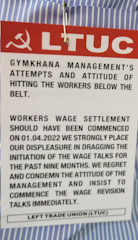
Another interesting feature was pinned to the shirt of one of the library staff. It was a rectangular plastic badge with a hammer and sickle on both of its sides. One side had words in Tamil, and the other in English. These words explain to the reader that there was a grievance between the staff and their employers, The Club. The problem about which the employees were protesting concerned pay. Seeing these badges of protest reminded me of a visit to Nizam’s restaurant in Kolkata a few years ago. There, the waiters were wearing similar badges, some in Bengali, some in Hindi, and others in English.
As for the library, it seemed well stocked with books and journals. Several old books were being sold, and there were three that I could not resist!
January 12, 2023
The bodies which came back to life
AT ABOUT FIVE in the morning, a taxi dropped us off at the Madras Gymkhana Club in Chennai. It was late February 1994, and we had just disembarked from an overnight train from Bangalore. We were going to rest at the Club before taking a flight to Colombo in Sri Lanka.
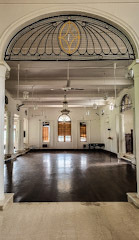
Today, the 8th of January 2023, we revisited the Gymkhana Club, and seeing the place reminded me of a strange experience we had there back in February 1994. The Club, which was founded in 1884, has as its main building an edifice gifted by the Rajah of Venkatanagiri in 1886. Compared with the Madras Club, south of it, its architecture is far less refined.
When we got out of our taxi before daybreak in February 1994, we entered the main building, which was unlit at such an early hour. The night watchman at the reception desk asked us to sit in some armchairs near the entrance until the morning receptionist arrived. After sitting for a while in the hot, humid reception area, the sun began to rise and the Club’s interior began to become visible slowly.
I noticed that we were sitting close to a very large room. As the light improved, I saw that the room was filled with tables. The tables were covered with napkins, cutlery, and plates of unfinished food. Alongside the tables, there were bodies lying on the floor. Soon after dawn, these bodies came to life. They belonged to the Club’s staff – waiters and so on. These people then proceeded to clear up the remains of the previous night’s banquet. Maybe, they had finished too late at night to make it worthwhile to return to their homes for a few hours.
Seeing these people lying in the gloomy light of daybreak and then coming back to life was a memorable experience. Visiting the Gymkhana Club today, 29 years later, evoked this memory powerfully.
Our brief visit to the Club today was quite different. The place seemed far from sleepy, and we received a warm welcome.
January 11, 2023
A short bus journey in Chennai
IT WAS VERY HOT when we decided to travel from Chennai Central Railway Station to the city’s Indo-Saracenic style High Court, which is about a mile away. A policewoman told us that it was too far to walk, so we must take a bus. Following her sensible advice, we boarded a local city bus.
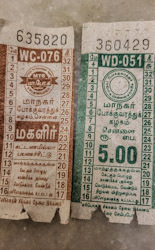
As with all buses in India, there was a conductor on boarf who sold tickets. On enquiring the cost, we were told that the price was 5 rupees. We asked if that was per ticket or for the two of us. The conductor replied that my ticket was 5 rupees and that on his bus women travel free of charge. Then, he gave us two fragile paper tickets. One was marked with a large ‘5’ and the other was covered with Tamil script, but no ‘5’ (except a small one in the ticket’s six digit serial number). A friend, who reads Tamil, explained that the brown ticket without the large 5 reads ‘lady’s ticket’.
After travelling one stop, we disembarked in a busy street market, and walked about a quarter of a mile to the impressive, oriental-looking Court building’s, which were constructed between 1888 and 1892, to the designs of architects JW Brassington, Henry Irwin, and JH Stephens. As we had committed no misdemeanors and had no legal work to do, we could not enter the complex of buildings.
The saying goes ‘there’s no such thing as a free lunch’, but during our visit to central Chennai, we discovered that there is such a thing as a free bus ride!
January 10, 2023
A strange notice in a railway station
BE THEY LARGE OR SMALL, I always enjoy railway stations. Today, the 7th of January 2023, we visited the Central Station in Chennai (Madras). This huge edifice is also known as ‘Puratchi Thalaivar Dr. M.G. Ramachandran Central Railway Station’. It is the busiest station in southern India. When we visited it at about 11 am, it seemed rather sleepy even though there were many people waiting for their trains.
The station was designed by a British architect George Harding. Its distinctive exterior has neo-Romanesque decorative features. It was first opened in 1873, but was rebuilt twice: in 1959 and 1998.
We bought coffees to drink in a canteen within the station. After paying at the cash desk we were given two small plastic discs, like counters used in board games. Each disc had the word “coffee” printed on one side of it. We handed these to a lady who prepared excellent South Indian filter coffee.
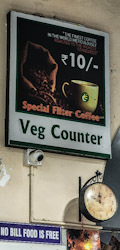
The walls of this small café-cum-restaurant are decorated with murals depicting Chennai and the Central Station. Numerous informative notices were also displayed in the walls. One informed customers that all of the water used had been filtered. Another forbids the eating of “outside food”, which means food not bought in the canteen. Yet another reassured customers that “medium refined” cooking oil was used in the kitchen. And another warned clients that they are under cctv surveillance.
One notice puzzled us. It reads: “NO BILL FOOD IS FREE”. Grammatically, it made no sense to us. We asked another customer, who was standing close to us, if she could explain. She smiled, revealing a set of teeth that would have benefitted from orthodontic treatment, and then, as quick as a flash, she explained that these words mean that without paying, no food will be served.
January 9, 2023
Armenian script in a church in Chennai
I HAVE VISITED ST THOMAS Mount in Chennai twice so far. The two visits were separated by at least a quarter of a century. Amongst the many interesting things to see and experience on this sacred hill are some examples of Armenian script. This characteristic lettering can be found both on several tombstones and on some framed paintings of saints. Also, there is some Armenian writing inscribed on an ornate pulpit.
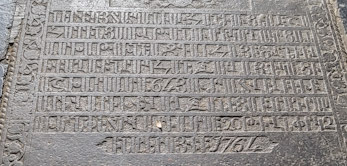
The church on the Mount is dedicated to Our Lady of Expectation. There are several sculptures of the pregnant Mary in or near the church, which was constructed close to the spot where St Thomas (the doubter) is supposed to have died. The church was constructed by Portuguese Franciscan missionaries in the 1520s. None of this information provides any clues to the presence of the Armenian lettering.
Armenians began setting in Madras in significant numbers in the mid-17th century. There is an Armenian Street in Chennai, where one can find an Armenian church. This was built in 1712. The two funerary monuments I saw on the Mount are dated after 1712: 1739 and 1764. The paintings with Armenian script are far newer. I am no expert on Armenia, so can say little if anything about their religious practices. Many Armenians are Christians, and a few of them are of the Catholic variety. I can only assume that the graves on the Mount are those of Catholic Armenians, and that some Catholic Armenian donor provided the paintings.
If anyone can give me more information about the presence of Armenian script in this church on the Mount, please share it with me.
January 8, 2023
Curiosity and the cat
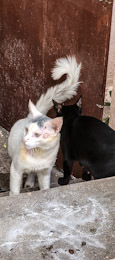
Can you tell me
If the cat’s happy or sad
By the shape of its tail?
January 7, 2023
A saint and a surveyor
SAINT THOMAS MOUNT in Chennai is best known for being the place where St Thomas was martyred (by whom I have no idea). A friend in Bangalore, John Fernando, told me that apart from the much-revered saint, another notable person is commemorated on the summit of the Mount. His bust can be found near the east end of the church almost hidden away between a couple of banyan trees. The bust is a depiction of the British Colonel, William Lambton (1753-1834).

It is appropriate that the soldier Lambton is commemorated on the summit of the Mount. For, it was from this lofty place that in 1800 he commenced his trigonometric fieldwork for his project, a great trigonometric survey of India.
To quote Wikipedia, Lambton’s:
“… initial survey was to measure the length of a degree of an arc of the meridian so as to establish the shape of the Earth and support a larger scale trigonometrical survey across the width of the peninsula of India between Madras and Mangalore. After triangulating across the peninsula, he continued surveys northwards for more than twenty years. He died during the course of the surveys in central India and is buried at Hinganghat in Wardha district of Maharashtra.”
Lambton’s assistant was George Everest (1790-1866), who succeeded him as Surveyor General of India. Everest is associated with a famous Peak in the Himalayas. However, it was not him but two others, Andrew Scott Waugh and Radhanath Sikdar, who ascertained the mountain’s height.
I am grateful to John for mentioning Lambton’s memorial to me. Even without seeing this bust, a visit to Saint Thomas Mount is worthwhile as there is much of interest to see there including an old church built by the Portuguese, gravestones and paintings with Armenian script on them, and the vibrant nature of Indian Christianity.
January 6, 2023
Two in one
THE GOVERNMENT MUSEUM in Chennai has a magnificent collection of mostly early medieval Hindu and Buddhist bronze sculptures. One of these wonderful religious artworks was exceptionally interesting. At first sight, it seems like a sculpture of a human figure, but soon you will notice many odd things about it.
The figure has two right arms and one left arm. It’s left breast is female in form. The right is male. The right side of the torso has male characteristics, but the left side has sensuous female curves. As for tthe shapes of the buttocks, the right one is different from the larger left one. The right leg is largely unclothed, but the left is covered with a depiction of a cloth covering.
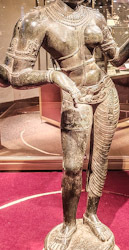
The statue I gave been describing is half male and half female. According to an information panel nearby, this sculpture is an 11th century depiction of Artanarishvara. It is a composite of Shiva (right half) and Parvati (left half). It represents the belief that the Godhead, Shiva, and his consort, Parvati, cannot exist without each other. It also shows that without the coexistence of male and female, human life cannot be propagated and continued. No doubt, there is much more meaning encompassed in this interesting sculpture, but I am not competent to discuss this further. Suffice it to say, seeing this unusual sculpture gave me food for thought.
Until today, I had never seen an Artanarishvara. This beautifully crafted work was one of many lovely pieces in the bronze collection of Chennai’s version of the British Museum.
January 5, 2023
An empty cupola in Chennai
ONE OF THE FIRST things that a visitor sees when entering Chennai’s Fort St George is a cupola supported by eight fluted pillars topped with Ionic capitals. It looks as if it ought to contain something, but it is empty.
In 1792, after losing a military campaign against the army of the British East India Company, the ruler of Mysore, Tipu Sultan, surrendered two of his sons as hostages to be held by the British. They were handed over to the British commander Lord Cornwallis. Tipu’s sons were taken to be held by the British until he had paid them an enormous sum of money, deemed to be reparations for damages that were supposed to have been inflicted on his British opponents. He managed to pay this ‘ransom’ after a couple of years, and his sons were returned.
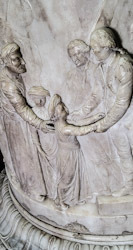
Cornwallis was regarded as a great hero by the British. In about 1800, Thomas Banks sculpted an enormous stone statue of Cornwallis standing on a tall stone cylindrical base. The base has figures sculpted in bas-relief. The bas-relief depicts the moment when Tipu’s sons were handed over to Cornwallis.
At first, the statue was housed in the above-mentioned cupola. Later, it was moved indoors, first to the Long Room of the Connemara Library, and then later to the museum in Fort St George. It was moved indoors from its original position beneath the cupola, because, to quote an informative panel near it:
“… of ill feeling caused by certain reliefs on its base.”
Well, at least it was never toppled to the ground as was the case with, for example, statues of Stalin, Enver Hoxha, and the Bristol slaver Edward Colston.
January 4, 2023
Seated on a temple

High on a corner
Watching life passing by
The deity sits still



